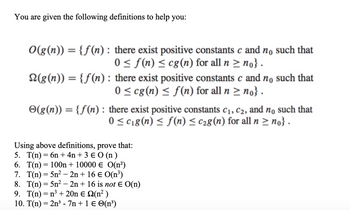
Database System Concepts
7th Edition
ISBN: 9780078022159
Author: Abraham Silberschatz Professor, Henry F. Korth, S. Sudarshan
Publisher: McGraw-Hill Education
expand_more
expand_more
format_list_bulleted
Question
8,9,10

Transcribed Image Text:You are given the following definitions to help you:
O(g(n)) = {f(n): there exist positive constants c and no such that
0 ≤ f(n) ≤ cg(n) for all n ≥ no} .
N(g(n)) = {f(n): there exist positive constants c and no such that
0 ≤ cg (n) ≤ f(n) for all n ≥ no} .
©(g(n)) = {f(n): there exist positive constants C₁, C2, and no such that
0 ≤ c₁g(n) ≤ f(n) ≤ c₂g (n) for all n ≥ no} .
Using above definitions, prove that:
5. T(n) = 6n + 4n+ 3 € 0 (n)
6. T(n) = 100n + 10000 ��� O(n²)
7. T(n) = 5n² - 2n + 16 € O(n³)
8. T(n)=5n² - 2n + 16 is not € O(n)
9. T(n) = n³ + 20n € №(n² )
10. T(n) = 2n³ - 7n + 1 € ☺(n³)
Expert Solution
This question has been solved!
Explore an expertly crafted, step-by-step solution for a thorough understanding of key concepts.
Step by stepSolved in 4 steps

Knowledge Booster
Learn more about
Need a deep-dive on the concept behind this application? Look no further. Learn more about this topic, computer-science and related others by exploring similar questions and additional content below.Similar questions
- 1 2 3 4 P46 6 7 8 9 10 11 12 13 14 15 16 17 18 19 20 21 22 23 24 25 26 27 28 29 30 31 32 33 34 35 36 37 38 39 40 41 42 43 44 45 46 47 48 49 50 File 51 52 53 54 55 Paste A Ready E Home Insert Page Layout Cut Copy Format Painter Clipboard B Character Carlton Lassiter Dale Cooper David Addison Dexter Morgan Dr. Elliot Reid Dr. Gregory House Edmund Blackadder Eric Cartman Fox Mulder George Costanza Gloria Pritchett Hank Hill Harold T. Stone Harry Solomon Homer Simpson Hurley Reyes Jack Bauer Jack Malone Jeff Greene ▬▬▬▬▬ Jim Ignatowski John Locke Kim Bauer Liz Lemon ▶ Lorelai Gilmore Lynette Scavo Maddie Hayes Matt Saracen Monica Bing Natalie Teeger Niles Crane Norm Peterson Phil Dunphy Phillip J. Fry X Arial BI U Show fix Formulas Data Type here to search H Question 4- Fill the respective data in blank cell from the data given below using excel functions Font D 10 g ▼ E Character Maddie Hayes Sam Malone David Addison Adrian Monk Jeff Greene Norm Peterson Matt Saracen Barney Stinson Bill…arrow_forwardSubject: Computer Organization and Architecture 3aarrow_forwardProvide an explanation of the term "aspect ratio."arrow_forward
- Which phase of the moon would be seen immediately after the one below it?arrow_forwardSpecifications for observing angles of an n-sided polygon limit the total angular misclosure to E. Part A How accurately must each angle be observed for n = = 7 and E±8"? Express your answer in seconds to two significant figures. ΜΕ ΑΣΦ Η vec d=2100000 Submit ▾ Part B Previous Answers Request Answer ? How accurately must each angle be observed for n = = 8 and E±10"? Express your answer in seconds to two significant figures. ΜΕ ΑΣΦ IT vec σ = 1.1 Submit Previous Answers Request Answer × Incorrect; Try Again; 5 attempts remaining < Return to Assignment Provide Feedback ? " Reviearrow_forward"How do vertex shaders and fragment shaders play a role in 3D graphics processing?"arrow_forward
arrow_back_ios
arrow_forward_ios
Recommended textbooks for you
 Database System ConceptsComputer ScienceISBN:9780078022159Author:Abraham Silberschatz Professor, Henry F. Korth, S. SudarshanPublisher:McGraw-Hill Education
Database System ConceptsComputer ScienceISBN:9780078022159Author:Abraham Silberschatz Professor, Henry F. Korth, S. SudarshanPublisher:McGraw-Hill Education Starting Out with Python (4th Edition)Computer ScienceISBN:9780134444321Author:Tony GaddisPublisher:PEARSON
Starting Out with Python (4th Edition)Computer ScienceISBN:9780134444321Author:Tony GaddisPublisher:PEARSON Digital Fundamentals (11th Edition)Computer ScienceISBN:9780132737968Author:Thomas L. FloydPublisher:PEARSON
Digital Fundamentals (11th Edition)Computer ScienceISBN:9780132737968Author:Thomas L. FloydPublisher:PEARSON C How to Program (8th Edition)Computer ScienceISBN:9780133976892Author:Paul J. Deitel, Harvey DeitelPublisher:PEARSON
C How to Program (8th Edition)Computer ScienceISBN:9780133976892Author:Paul J. Deitel, Harvey DeitelPublisher:PEARSON Database Systems: Design, Implementation, & Manag...Computer ScienceISBN:9781337627900Author:Carlos Coronel, Steven MorrisPublisher:Cengage Learning
Database Systems: Design, Implementation, & Manag...Computer ScienceISBN:9781337627900Author:Carlos Coronel, Steven MorrisPublisher:Cengage Learning Programmable Logic ControllersComputer ScienceISBN:9780073373843Author:Frank D. PetruzellaPublisher:McGraw-Hill Education
Programmable Logic ControllersComputer ScienceISBN:9780073373843Author:Frank D. PetruzellaPublisher:McGraw-Hill Education

Database System Concepts
Computer Science
ISBN:9780078022159
Author:Abraham Silberschatz Professor, Henry F. Korth, S. Sudarshan
Publisher:McGraw-Hill Education

Starting Out with Python (4th Edition)
Computer Science
ISBN:9780134444321
Author:Tony Gaddis
Publisher:PEARSON

Digital Fundamentals (11th Edition)
Computer Science
ISBN:9780132737968
Author:Thomas L. Floyd
Publisher:PEARSON

C How to Program (8th Edition)
Computer Science
ISBN:9780133976892
Author:Paul J. Deitel, Harvey Deitel
Publisher:PEARSON

Database Systems: Design, Implementation, & Manag...
Computer Science
ISBN:9781337627900
Author:Carlos Coronel, Steven Morris
Publisher:Cengage Learning

Programmable Logic Controllers
Computer Science
ISBN:9780073373843
Author:Frank D. Petruzella
Publisher:McGraw-Hill Education